
Security News
Deno 2.6 + Socket: Supply Chain Defense In Your CLI
Deno 2.6 introduces deno audit with a new --socket flag that plugs directly into Socket to bring supply chain security checks into the Deno CLI.
bitbox02-api
Advanced tools
The JavaScript library is compiled from bitbox02-api-go using GopherJS.
Given that it contains the full client implentation compiled from Go, the library is quite large (~3MB), we recommend lazy-loading it only when necessary.
To compile:
$ make dockerinit
$ make dockercompile
To run a demo: $ make servedemo and visit localhost:8000
To talk to the device from a browser using this API, you will need the BitBoxBridge: https://github.com/digitalbitbox/bitbox-bridge To integrate the BitBox02 into your application, your domain will need to be whitelisted in the Bridge. To do so, please submit a Pull Request or an Issue in the bitbox-bridge repo.
$ npm install bitbox02-api
import { BitBox02API, getDevicePath} from 'bitbox02-api';
To get the device path, the BitBoxBridge needs to be running
const devicePath = await getDevicePath();
const BitBox02 = new BitBox02API(devicePath);
The BitBox02API.connect() method takes 5 arguments:
/**
* @param showPairingCb Callback that is used to show pairing code. Must not block.
* @param userVerify Promise that should resolve once the user wants to continue.
* @param handleAttastionCb Callback that should handle the bool attestation result. Must not block.
* @param onCloseCb Callback that's called when the websocket connection is closed.
* @param setStatusCb Callback that lets the API set the status received from the device.
* @return Promise that will resolve once the pairing is complete.
*/
connect (showPairingCb, userVerify, handleAttestationCb, onCloseCb, setStatusCb)
For more detailed example see the Sample integration below.
Get eth xpub for a given coin and derivation path
/**
* @param keypath account keypath in string format
* Currently only two keypaths are supported:
* - `m/44'/60'/0'/0` for mainnet and
* - `m/44'/1'/0'/0` for Rinkeby and Ropsten testnets
* @returns string; ethereum extended public key
*/
const rootPub = await BitBox02.ethGetRootPubKey(keypath: string);
To sign Ethereum transactions, we recommend using the Transaction type provided by the ethereumjs library https://github.com/ethereumjs/ethereumjs-tx/blob/master/src/transaction.ts.
Then to send the data to the device and get the signature bytes:
/**
* Signs an ethereum transaction on device
* @param signingData Object;
* signingData = {
* keypath, // string, e.g. m/44'/60'/0'/0/0
* chainId, // number, currently 1, 3 or 4 for Mainnet, Ropsten and Rinkeby respectively
* tx // Object, either as provided by the `Transaction` type from `ethereumjs` library
* // or including `nonce`, `gasPrice`, `gasLimit`, `to`, `value`, and `data` as byte arrays
* }
* @returns Object; result with the signature bytes r, s, v
* result = {
* r: Uint8Array(32)
* s: Uint8Array(32)
* v: Uint8Array(1)
* }
*/
const result = await BitBox02.ethSignTransaction(signingData);
/** @param msgData is an object including the keypath and the message as bytes/Buffer:
*
* const msgData = {
* keypath // string, e.g. m/44'/60'/0'/0/0 for the first mainnet account
* message // Buffer/Uint8Array
* }
*
* @returns Object; result with the signature bytes r, s, v
* result = {
* r: Uint8Array(32)
* s: Uint8Array(32)
* v: Uint8Array(1)
* }
*/
const result = await BitBox02.ethSignMessage(msgData);
/**
* @param keypath string, e.g. m/44'/60'/0'/0/0 for the first mainnet account
*/
await BitBox02.ethDisplayAddress(keypath)
To use with Ethereum, the user needs a BB02 Multi and not the Bitcoin Only edition. You can use for the following check:
import { api } from 'bitbox02-api';
BitBox02.firmware().Product() === api.common.Product.BitBox02Multi
BitBox02.firmware().Product() === api.common.Product.BitBox02BTCOnly
This is a sample BitBox02Wallet class integration for connecting to the BitBox02 device using the BitBoxBridge and this JS API.
For a functioning sandbox implementation, you can see demo.js: https://github.com/digitalbitbox/bitbox02-api-js/blob/master/demo/demo.js
import {
BitBox02API,
getDevicePath,
api,
sanitizeEthTransactionData
} from 'bitbox02-api';
class BitBox02 {
constructor(logout) { // You can provide the `logout` callback of your application in the constructor
this.logout = logout;
this.status = undefined;
this.pairingConfirmed = false;
}
async init(keypath) {
try {
const devicePath = await getDevicePath();
this.bitbox02API = new BitBox02API(devicePath);
await this.bitbox02API.connect(
/** @param showPairingCb
* Store the pairing code on the class instance. Show this to the user to compare with code
* on the device when `this.status === 'unpaired'`
*/
pairingCode => {
this.pairingCode = pairingCode;
},
/** @param userVerify
* Store the Promise's `resolve` on the class instance to call when the user clicks the corresponding button
* in your application after confirming the pairing on device
*/
async () => {
return new Promise(resolve => {
this.pairingConfirmed = true;
this.pairingConfirmationResolve = resolve;
});
},
/** @param handleAttastionCb
* Store the attestation result on the class instance. If attestation fails, the user might have a fake device.
* Handle this condition below.
*/
attestationResult => {
this.attestation = attestationResult;
},
/** @param onCloseCb
* Log the user out of your application when device is unplugged/the websocket closes.
* Here we use the `logout` function provided in the constructor as the callback.
*/
() => {
this.logout();
},
/** @param setStatusCb
* Store the status on the class instance to take appropriate actions based on status.
* All possible status can be found here: https://github.com/digitalbitbox/bitbox02-api-go/blob/master/api/firmware/status.go
*/
status => {
this.status = status;
}
);
} catch(e) {
alert(e);
this.logout();
return;
}
switch (this.bitbox02API.firmware().Product()) {
case api.common.Product.BitBox02Multi:
console.log("This is a BitBox02 Multi");
break;
case api.common.Product.BitBox02BTCOnly:
console.log("This is a BitBox02 BTC-only");
break;
}
// Handle attestattion failure
if (!this.attestation) {
alert('Attestation failed');
}
}
}
const device = new BitBox02(yourLogoutFunction)
await device.init()
// Now you can call any of the supported API methods documented above e.g.:
const ethPub = await device.BitBox02API.ethGetRootPubKey("m/44'/60'/0'/0");
FAQs
BitBox02 JavaScript library – To enable communication from the browser to the BitBox02 hardware wallet
The npm package bitbox02-api receives a total of 54 weekly downloads. As such, bitbox02-api popularity was classified as not popular.
We found that bitbox02-api demonstrated a not healthy version release cadence and project activity because the last version was released a year ago. It has 2 open source maintainers collaborating on the project.
Did you know?

Socket for GitHub automatically highlights issues in each pull request and monitors the health of all your open source dependencies. Discover the contents of your packages and block harmful activity before you install or update your dependencies.

Security News
Deno 2.6 introduces deno audit with a new --socket flag that plugs directly into Socket to bring supply chain security checks into the Deno CLI.

Security News
New DoS and source code exposure bugs in React Server Components and Next.js: what’s affected and how to update safely.

Security News
Socket CEO Feross Aboukhadijeh joins Software Engineering Daily to discuss modern software supply chain attacks and rising AI-driven security risks.